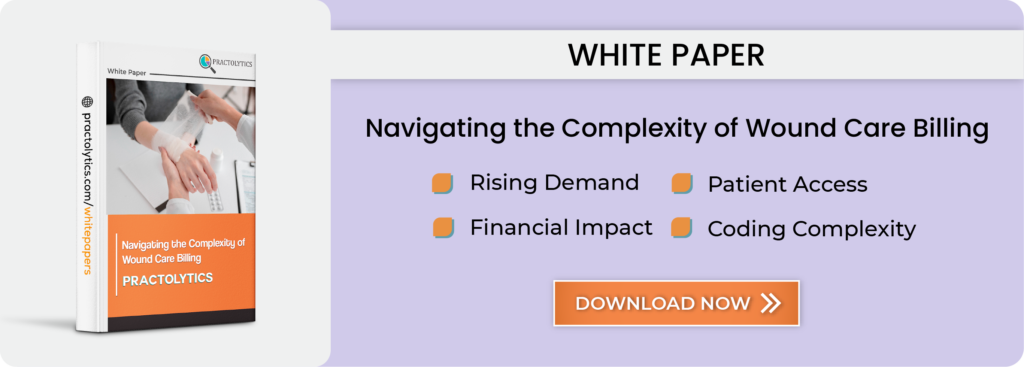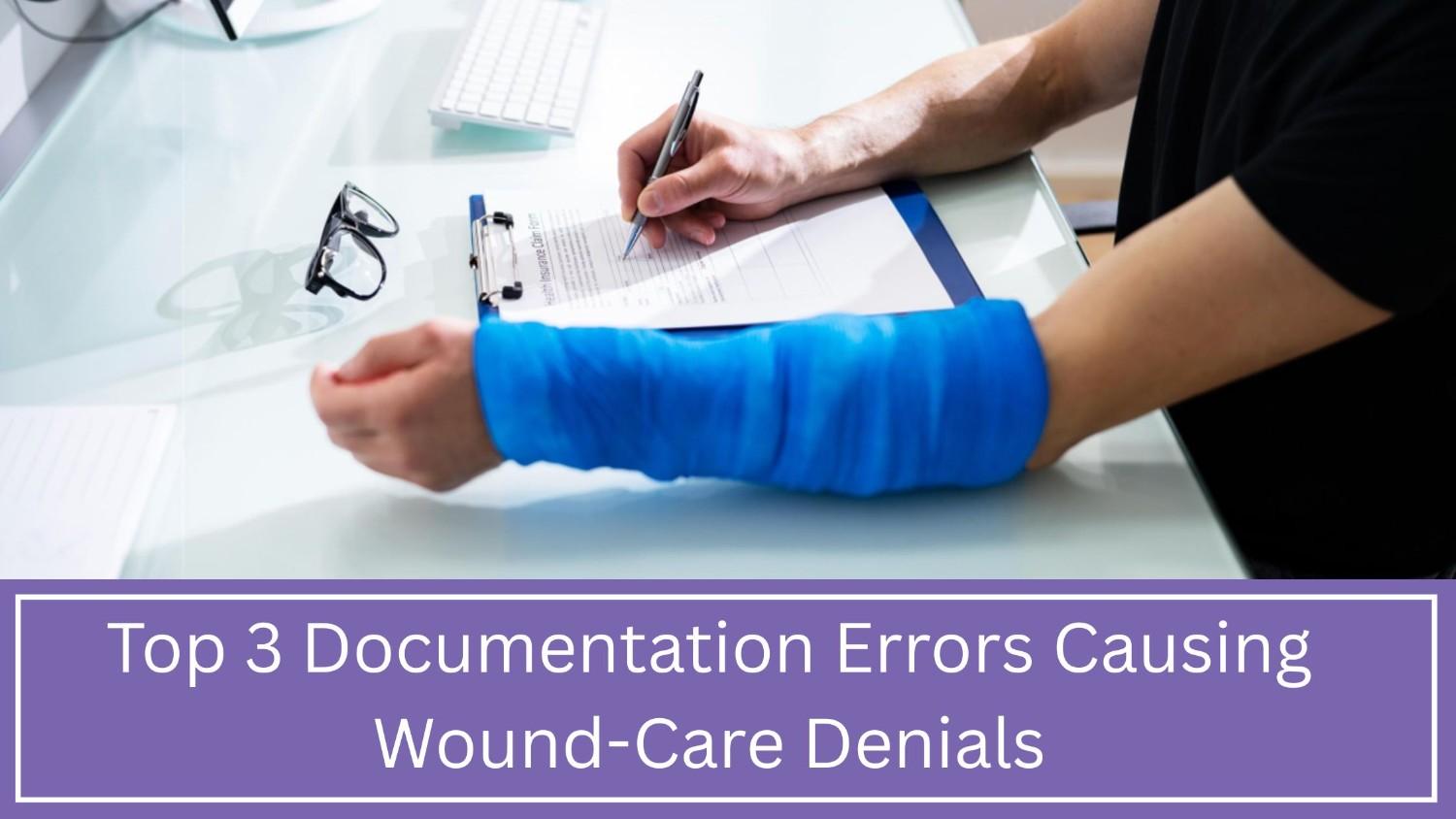Importance of Documentation in Wound Care Revenue Cycle Management (RCM)
In the realm of wound care Revenue Cycle Management (RCM), documentation serves as the backbone for accurate reimbursement and compliance with regulatory requirements. Thorough and precise documentation not only facilitates proper coding and billing but also ensures continuity of care and supports optimal patient outcomes. This blog explores the significance of documentation in wound care RCM and outlines best practices to achieve accurate reimbursement.
Table of Contents
Supporting Proper Coding and Billing
Comprehensive documentation provides the foundation for accurate coding and billing in wound care. Clinicians must capture detailed information about the type, size, location, and characteristics of wounds, as well as any associated complications or comorbidities. This information enables coders to assign the appropriate procedure and diagnosis codes, ensuring compliance with payer guidelines and maximizing reimbursement.
Demonstrating Medical Necessity
Documentation plays a crucial role in demonstrating the medical necessity of wound care services. Clinicians must justify the need for specific treatments, procedures, and supplies based on the patient’s clinical presentation and wound characteristics. Clear documentation of wound assessments, treatment plans, and progress notes helps substantiate the medical necessity of services rendered, reducing the risk of claim denials and appeals.
Ensuring Continuity of Care
Accurate and comprehensive documentation promotes continuity of care by providing a detailed record of the patient’s wound history, treatment interventions, and response to therapy. This allows for seamless communication and collaboration among healthcare providers involved in the patient’s care, ensuring that all stakeholders are informed and aligned regarding the patient’s clinical status and treatment goals.
Supporting Quality Reporting and Performance Metrics
Documentation serves as the basis for quality reporting and performance metrics in wound care. Clinicians must accurately document key performance indicators such as wound healing rates, infection rates, and patient satisfaction scores to measure the effectiveness of care delivery and identify opportunities for improvement. Timely and detailed documentation enables providers to track outcomes, benchmark performance against industry standards, and drive quality improvement initiatives.
Mitigating Compliance Risks
Comprehensive documentation helps mitigate compliance risks by ensuring adherence to regulatory requirements and billing standards. Clinicians must document services accurately and ethically, avoiding over coding, under coding, or unbundling of services that could result in compliance violations or fraudulent activity. Regular staff education and audits of documentation practices are essential for maintaining compliance and mitigating the risk of penalties or sanctions.
Best Practices for Documentation in Wound Care RCM:
Standardized Templates and Workflows: Implement standardized documentation templates and workflows tailored to wound care assessments and treatments to promote consistency and completeness.
Real-Time Documentation: Encourage clinicians to document wound care services in real-time to ensure accuracy and timeliness of documentation.
Detailed Descriptions: Provide guidance to clinicians on the importance of detailed descriptions of wounds, treatments, and interventions to support accurate coding and billing.
Interdisciplinary Collaboration: Foster interdisciplinary collaboration among wound care team members to ensure comprehensive documentation of all aspects of patient care.
Regular Training and Education: Offer ongoing training and education to clinicians on documentation best practices, coding guidelines, and regulatory requirements relevant to wound care billing.
In conclusion, documentation is a cornerstone of wound care RCM, playing a vital role in ensuring accurate reimbursement, supporting quality care delivery, and mitigating compliance risks. By implementing best practices for documentation and fostering a culture of documentation excellence, providers can optimize revenue, enhance patient outcomes, and maintain compliance with regulatory standards in the dynamic healthcare landscape.
In the intricate world of wound care Revenue Cycle Management (RCM), documentation stands as the linchpin for accurate reimbursement and regulatory compliance. Practolytics, our innovative RCM solution, emerges as the catalyst for elevating documentation excellence to new heights, empowering providers to navigate the complexities of the revenue cycle with precision and confidence.
By integrating Practolytics into your organization’s workflow, you gain access to a suite of advanced tools and resources designed to streamline documentation processes and optimize reimbursement outcomes. Practolytics’ intuitive documentation templates and standardized workflows facilitate real-time capture of comprehensive wound care assessments, treatments, and progress notes, ensuring accuracy and completeness at every stage of patient care.
Moreover, Practolytics enables interdisciplinary collaboration among wound care team members, fostering communication and coordination to capture all relevant clinical information seamlessly. With Practolytics, clinicians can leverage standardized documentation practices tailored to wound care, supported by real-time feedback and guidance to ensure compliance with coding guidelines and regulatory requirements.
Practolytics’ robust analytics and reporting capabilities provide actionable insights into documentation trends, coding accuracy, and compliance metrics, empowering providers to identify areas for improvement and drive performance excellence. Through ongoing training and education facilitated by Practolytics, clinicians can stay abreast of evolving regulatory standards and best practices, fostering a culture of documentation excellence within the organization.
In partnership with Practolytics, providers can unlock the full potential of documentation in wound care RCM, achieving accurate reimbursement, promoting continuity of care, and mitigating compliance risks effectively. With Practolytics as your trusted ally, documentation excellence becomes not just a goal, but a strategic advantage in delivering high-quality wound care while maximizing revenue opportunities and ensuring regulatory compliance.
Together, let us embark on a journey towards documentation excellence with Practolytics, transforming the way we approach wound care RCM and driving success in the dynamic healthcare landscape. With Practolytics, the future of documentation in wound care is brighter than ever, empowering providers to thrive in an era of innovation and excellence.
Read More – Tackling Denials in Wound Care Billing: RCM Solutions for Improved Cash Flow
Talk to Medical Billing Expert Today — Get a Free Demo Now!






